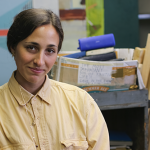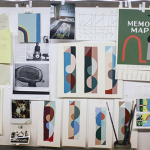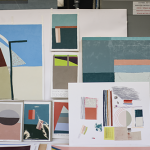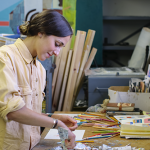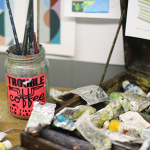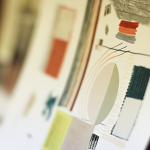Perhaps the only thing as momentous as a moment itself is the memory of it, that self-imposed, self-etched recollection. And even as subjective as memories may be, they offer a ledge on which to step back and reassess escaped moments in time through our unconscious preferences, which is often a beautiful thing.
Artist Kristin Texeira paints to preserve these fleeting moments, and it’s with great intuition and care that she handles not only her own rememberings, but those of others as well. Using the potency of colors—what they represent both in past and in real time—Texeira relays memories as surveys of life through her Memory Maps, collections of murky yet lucid structural portals.
Not always geographically accurate or sequential, her paintings instead outline the interpretive tokens we take from each memory, freeing them from their situation in time to become a beautiful work of recorded art.
Her upcoming show on Cape Cod, in Provincetown, MA, recounts findings from her first trip to the tip of the Cape, a week immersed in the town and its communal thread. The result is a series of recollections—places, people and moments—of the foggy eastern coastal town, translated in color and the feelings they evoke. A tangible timestamp of Texeira’s intimate construals. With the opening reception of her gallery exhibit this Saturday, May 28, at Room 68, we spoke with Texeira about her documented memorials and what it means to map your past. Shots of Texeira in her studio by photographer David Dyte.
Give us the Kristin Texeira spiel. What’s one thing most people don’t know about you?
I’m from West Bridgewater, Massachusetts, and I went to school at Mass Art in Boston. I graduated in 2010 and bogged around a lot afterwards—I lived in San Francisco a couple different times and also did a lot of work on Martha’s Vineyard. Because my artwork is based on travel and meeting new people and hearing new stories, I took new jobs and art residencies that took me to new places and I met a lot of new people that way. I did a residency at The Vermont Studio Center and met a lot of great people there from Brooklyn, which really piqued my interest, and I eventually moved to Brooklyn in 2013.
I try my best to get out of the city as much as I can to keep myself refreshed from this crazy place. My current studio is in the Navy Yard in Brooklyn. I work in a letterpress studio (Woodside Press) where beautiful old machines and type that fill the space. The guy that runs the studio was nice enough to let me rent out a little corner spot, so I’ve been the oddball in the corner where I made my mark and keep slowly spreading outward. It’s a great place to have a studio.
One thing most people don’t know about me? I’m a huge Nas fan.
What are your earliest memories of art and art-making?
Growing up, I spent a lot of time at my grandparents’ house. I was by myself a lot and found ways to keep myself busy, especially with coloring books. My grandparents let me collage all over their living room walls with cutouts from my coloring books and use those crappy watercolors to paint on their window sills. They really let me have at it, which was kind of awesome.
I was just always in my own head and that was my way to pass the time; I’m the oldest in my family, so I didn’t have many people to hang with. Any time we had a poster project in grade school, I would go all out and spend a lot of time on the art side of things. I always had an inclination that I wanted to be an artist, and, luckily I just stuck with it through college.
What is your creative process like? How to these words, shapes and colors come together in your mind?
My work is pretty abstract, but it all, for the most part, comes from something specific and something from the real world. A lot of my work starts as writing—I always carry a sketch book with me; I’ve filled so many in the past ten years—jotting down memories or dialogue with people, and then I translate those through color. For me, when I recall these memories, certain colors come to mind—ideas get translated into color and that’s how I arrive at my paintings, this interchangeable world of writing and listening and how it all turns into color.
I favor subtle shifts in color, and I never really work with colors straight from the tube—I’ll mix colors first and from them I’ll mix even more colors, so they get more and more complex. Warm peaches and softer blues—I think I favor them because I grew up around them.
I was doing a project and realized that the eggshell blue that I’m always drawn to is from my grandmother’s home—her bedroom and living room walls—and I think something innate in me brings me to that.
I like to emanate a certain feel from these images, and as I’m recalling these memories those lighters tones are a source of nostalgia for me. When you’re recalling memories it’s sort of in a haze, which is where those softer colors come from.
For the past year I’ve only been painting—oils on paper. When I’m just messing around I use collages—something I used to do when I was running out of ideas or needed a blank mind. Whenever I collage, it’s not really referring to memories, just like an exercise for myself: putting a mark on the paper and then reacting to it.
Some days I’ll mix colors to give my brain a break; others days, I’m like, ok, I’m buckling down and making a memory map, something concrete.
Tell me a little bit about your memory maps—what motivated them? How dependent on geography are they? What does a map really incite for you?
It started happening without me really knowing it. I’ve always been working with the subject of memory and time and, originally it was a little more abstract than what it is now: more colors of places and colors of people as I was experimenting with how to arrange and display those colors and tell the story through color. Eventually, I found myself working on a project of painting how I remembered my grandmother’s home, something I was probably references from when I was five or six years old. It was challenging myself to try to walk down the halls again and visualize it. I wanted a way to preserve those places before they completely left my memory. Those were the first four maps I made, and went from there, either mapping homes of friends I visited or their childhood homes. Lately, it’s been really great because people have been coming to me with memories of their own and want me to translate their memories into a panting. They want that token. I like that my work can have a purpose for someone else, rather than just something extra that I’m putting out into the world and hoping someone will like. I still have the creative side for me, but I can offer a service for others as well.
When I’m doing maps based on personal memories I get into almost a trancelike space, and I can almost—I call it time traveling—go back into this place and picture the turns I’m making in a space and I really try to mediate on every detail I can extract. My hand moves on the page to translate where I am in my mind onto paper, so it’s really like I’m in two places at once. [With personal memory maps] it’s less so about thinking back and more me going back in time.
With other people’s stories I try to tell the story on paper from left to right, so I start with the information they give me first and just start from one end and move over, and that’s been kind of funny because they may imagine it differently set up on page versus what’s logical to me.
What can we expect at your upcoming show in Provincetown, MA?
A lot of 5 x 7 painting that are minor details of Provincetown. [During the time I spent there] I took walks every day. Actually, the first chunk of time there I still had the New York clock in me and tried to hustle, and then the last couple days I tried to interact with the locals and off-season people and got so much more information from them, just sitting at the bar and listening to these funny stories. It was especially cool because I visited on the cusp of an offseason ghost town, so I met locals during the week but on weekends it filled up. This was my first time there and whenever I go to a new place my eyes are the widest, which made it so nice.
For more from Kristin, visit her website, on Uprise Art or follow her on Instagram.
- photo by David Dyte
- photo by David Dyte
- photo by David Dyte
- photo by David Dyte
- photo by David Dyte
- photo by David Dyte
- photo by David Dyte
- photo by David Dyte



